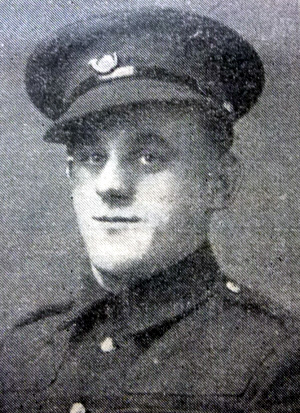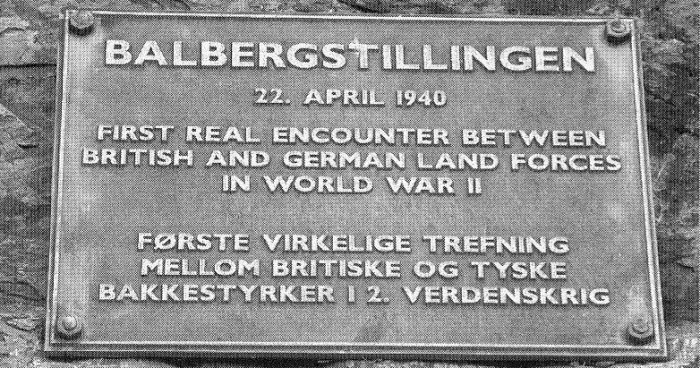
John Nightingale was born in Ossett in 1917, the youngest child of Sam Nightingale and Florence Peace who married in 1895 in the Dewsbury Registration District. John had at least three older siblings: Arthur Nightingale, born 1912; Sam Nightingale, born 1914 and Annie Nightingale, born 1915.
John Nightingale married Mary Illingworth in Horbury in January 1940 and they had a daughter Patricia M. Nightingale in the summer of 1940. Tragically, Mary Nightingale was pregnant with their second child, John, who was born in the winter of 1940, just a few months his father’s death.
Germany attacked Norway April 9th 1940 and took possession of a number of towns, among those Trondheim. Britain and France sent troops to help the Norwegians and British and French forces were landed in Namsos. In co-operation with the Norwegian troops, their mission was to reconquer Trondheim.
Almost two-thousand British soldiers landed in Norway during the evening of April 18th, 1940. On May 2nd, one hundred and sixty three men were rescued by the Royal Navy from one of the most ill-planned operations of World War II. The German Army Group ‘Pellengahr’ was already established in Southern Norway, the western coastal towns and Trondheim in the North. When the British landed the Germans were already marching north to meet them, pushing the Norwegian Army backwards. These were the first British troops to understand the word Blitzkrieg, but the British Expeditionary Force in France would suffer the same fate, albeit on a larger scale – and the town of Dunkirk would take on a new significance.
146 Infantry Brigade, with Private Nightingale and 1/4 KOYLI were in the Namsos area of Norway, north of Trondheim and had clashed with the Germans near Verdalen, 45 miles north of Trondheim. On the 21st April 1940, 146 Brigade had been attacked by Germans who had landed from a cruiser and two destroyers and Steinkjer, location of the British HQ had been heavily bombed. The 146 Infantry Brigade at Namsos was now also being regularly bombed.
On the 22nd April 1940, as soon as conditions improved, the German Luftwaffe resumed their bombing on the British positions. During the late evening of the 22nd, 1/4 KOYLI started to withdraw from their held position at Vist in the face of mounting German pressure. They abandoned their heavier equipment, such as Bren-gun tripods, as they retreated towards Steinkjer. Enemy surveillance from the air was now so close that some soldiers abandoned their steel helmets to avoid recognition. In single file, with linked hands, they trudged through the deep snow towards the dull red glow which marked the burning town of Steinkjer. It took 4 hours to travel 1.5 miles.1
1/4 KOYLI during the short campaign in Norway lost four men killed, including Private John Nightingale and one seriously wounded. 44 of their number were missing, probably PoWs.

Above: Norwegian war memorial. April 22nd 1940 is considered the first days of real combat between the British and Germans. There apparently is some disagreement as to whether the first action took place at Steinkjer on 21 April, or in the Gudbrandsdal north of Lillehammer on 22 April.
An obituary for Private John Nightingale appeared in the “Ossett Observer” in 19402
“Former Ossett Church Worker – Private John Nightingale, aged 22, of 7, Cross Normanton Street, Horbury Junction was a native of Ossett, being the youngest member of the family of the late Mr. Sam Nightingale, of 14, Cross Ryecroft Street, Ossett. His father was a well-known local fruiterer and tenor singer, being a member of Ossett Parish Choir and Wakefield Cathedral Choir. Private Nightingale was married in January 1938 and leaves a widow and baby girl aged nine months.
Private Nightingale was a faithful adherent of the established church, being a server for some years at Ossett Parish Church and was to have been appointed to a similar position at St. Mary’s, Horbury Junction. After being educated at Holy Trinity church school, he became a bricklayer by trade and worked for a time on the railway at York where he was engaged in the construction of the new station.
He came to live in Horbury last Whitsuntide and had been employed for a short time at Crigglestone coke ovens. Private Nightingale was mentioned in prayers at Holy Trinity and Gawthorpe St. Mary’s on Sunday evening and on Thursday evening a memorial service was held at St. Mary’s Church, Horbury Junction.”
Private John Nightingale was killed in action on the 22nd April 1940 aged 22 years and is buried at A IV British. D. 5. at Trondheim (Stavne) Cemetery in Norway.3

Above: Steinkjer, Norway after the German bombing on April 21st 1940.
During the Second World War, Norway was of strategic importance to the Germans. Their invasion on 9 April 1940 was sudden and widespread and despite Allied intervention, the entire country was under German occupation by early June. Thereafter, Allied activity in Norway was confined to raids and special operations, with the Commonwealth air forces providing support to Norwegian resistance groups until the German capitulation in May 1945. There are no Commonwealth war cemeteries in Norway, those who died there being buried in civil cemeteries and churchyards.
Trondheim (Stavne) Cemetery contains the largest Commonwealth war graves plot in Norway. Among those buried here are the first casualties of the Norwegian campaign, six sailors from the destroyer Glowworm which blew up after attacking and ramming the German cruiser ‘Hipper’ on 8 April 1940. Some of the soldiers belonged to the force which landed at Namsos later that month and advanced towards Trondheim, while many were casualties from the raid made on the island of Vagsoy at Christmas 1941. The majority are airmen who were shot down in this area, many whilst attacking German shipping in Norwegian coastal waters, the losses being particularly heavy during the spring of 1942.
The Commonwealth plot at Trondheim contains 155 burials, 26 of them unidentified.
References:
1. “The Doomed Expedition – the campaign in Norway: 1940” by Jack Adams on Google Books.
2. “Ossett Observer”, Saturday June 8th 1940.